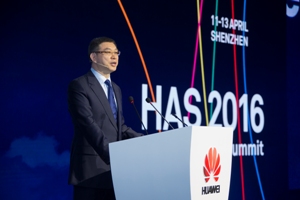Global information and communications technology (ICT) solutions provider, Huawei opened its 13th Global Analyst Summit in Shenzhen today. The event brings together more than 500 analysts, journalists and business leaders from the telecom, internet, finance, and other industries.
Reporting from Shenzhen, Jeremy Cowan said at the event is focusing on the theme of “Growing Together Through Digitalisation and Building a Better Connected World”. The company is discussing its strategic thinking, products, and market progress in the Internet of Things (IoT), cloud computing, and telco operations transformation.
Following keynotes from several Huawei Board members, the summit has heard today from representatives of industry organisations including NB-IoT Forum, China Mobile and China Unicom. Upcoming speakers include OpenStack, TM Forum, and The Open Group bringing their views and best practices on industry development.
Opening the event, William Xu, Huawei executive director of the Board and chief strategy marketing officer (CSMO) remarked, “Global digitalisation is accelerating, and this is improving efficiency and user experience in many areas, including vertical industries, public services, and every aspect of our lives.
Our Global Connectivity Index (GCI) 2016 reveals that global connectivity improved by 5% in 2015. We can work together in the areas of enhancing connectivity, enabling the digital transformation of vertical industries, improving the connectivity experience and expanding access under all scenarios, and to accelerate global digitalisation.”
Video has become a basic service of the telecom industry for consumer and business users and customer experience has become a core competence for operators if they are to attract and retain users. Huawei has unveiled a video experience measurement system, U-vMOS, which reasonably and objectively evaluates video quality, interaction, and the visual experience of various services on different networks and screens.
The system is open to the entire video industry, and has been recognised by the International Telecommunication Union (ITU). (Also see: IMS Networks choose Huawei WAN SDN solution for challenge of digital transformation, and Huawei helps MSOs accelerate video and broadband service opportunities.)
At the summit, Eric Xu, Huawei’s rotating CEO (the post of CEO rotates every six months among three CEOs) explained the company’s full “cloudification” strategy in detail. “At the Huawei Global Analyst Summit 2015, we proposed the Real-time, On-demand, All-online, DIY, and Social (ROADS) experience model to define the features of a superior user experience,” he said. “This year, we have introduced the full cloudification strategy, which focuses on delivering a ROADS experience.
At the core of Huawei’s full cloudification strategy is the full reconstruction of ICT infrastructure in four respects – equipment, network, services, and operations. The strategy aims to create systematic strengths in pooled hardware resources, fully distributed software architecture, and full automation. As a leading global ICT infrastructure provider, Huawei is committed to becoming an advocate, promoter, and leader of full cloudification.”
Digital transformation presents many opportunities as well as challenges. Huawei stays customer-centric and strives to help customers succeed and achieve shared success. Eric Xu (no relation) added, “In the carrier business, we aim to deliver a ROADS experience and help operators develop their competitiveness to seize new market opportunities including IoT, video, and cloud services.
We will also help migrate networks and operations systems to the cloud and help operators establish advantages in agile operations.” (Also see: Huawei unveils new software-led look as it plans ‘4.5G’ business to support mobile networks over next five years.)
“In the enterprise business,” he continued, “we will leverage cloud computing, SDN, and Big Data technologies to facilitate enterprise digitalisation towards agile and smart operations. In the consumer business, brand, quality, experience, and ecosystems matter most.
Huawei is working hard to develop a high-end brand, deliver premium products, win with quality and services, and establish an ecosystem that focuses on consumer experience.” (Also see: Huawei predicts deployment of 60 commercial 4.5G networks worldwide in 2016 and Vodafone, Huawei and u-blox claim ‘first successful commercial trial’ of pre-standard NB-IoT.)
“A Better Connected World raises requirements for networks. Connections, bandwidth, latency, and data storage must all achieve 100-fold improvements. More importantly, networks of the future must automatically accommodate diverse use scenarios, including massive numbers of connected things, high-bandwidth services like video and virtual reality, and industrial applications (including Industrial IoT, Ed.) that require a low latency and high reliability,” said Ryan Ding, Huawei executive director of the Board and president of Huawei’s Products & Solutions.
“Huawei will focus on ICT infrastructure and smart devices; invest over the long term; fully unleash the potential of connectivity, ultra-broadband, and data; and develop agile architecture and open platforms to accelerate the digital transformation of our customers, including operators.”
Customer needs are diverse, and no company can meet them on their own – collaboration with industry partners is essential. William Xu added: “We must join forces with industry partners to build an open ecosystem. We continue to hold fast to our pipe strategy, focusing on ICT infrastructure and smart devices.
To meet these needs, we have forged extensive partnerships with consulting firms, application developers, system integrators, and channel partners. Through this commitment to openness, collaboration, and shared success, we will create value for our customers, contribute to a healthy ICT ecosystem, and drive social progress.”
Comment on this article below or via Twitter: @ VanillaPlus OR @jcvplus






